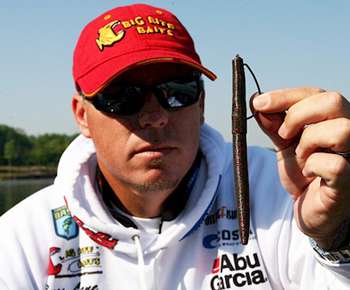
There is perhaps nothing that will psyche out a shallow-water power fisherman more quickly than clear water. Most power fishermen prefer to have some color to the water. Call it a crutch, but the thought is that if you can see the bottom in 3 feet of water, chances are very good that you'll spook many of the bass long before you can see them.
Elite Series pro Russ Lane is a noted power fisherman who prefers long rods and heavy line. His success points out that it is indeed possible for a power fisherman to get his fix in even the clearest of conditions. "When the water is in the low to mid 60s, it's a good sign that the majority of the fish in the lake are going to be near the bank," he says. "When they first get shallow they're a lot easier to catch, so finesse tactics aren't really what I'm going to use in that situation."
Instead, he explains that many of the same power techniques — particularly flipping — are just as effective in clear water. "A lot of people will put a small finesse worm on and pitch it around shoreline cover," he says. "One of my favorite things to do is to get a 6-inch Big Bite Trick Stick and Texas rig the bait on a 5/0 hook and 20-pound fluorocarbon. You can get away with using the heavier line because fluorocarbon is almost invisible in the water."
Many times, anglers will allow superclear conditions to dictate their target depth by assuming that, because they can see the bottom, there must not be any bass in the area. Lane disagrees emphatically. "To me, flipping clear water is a lot easier because you can see the underwater targets so much better," he says. "Natures does a good job of camouflaging the fish, but if you can see the targets from a long way off you can almost bet a fish is there."
The key is being quiet in your approach. "You won't believe how many bites you can get in superclear water if you're making long pitches and just being as quiet and still as possible," he adds. When water temps are in the low to mid 60s, Lane maintains that most of the fish you're catching will be prespawn, but that's not a hard-and-fast rule. "With water temps that low, most of the fish are just moving up," he says. "You'll find that you're going to catch fish in all stages of the spawn though — from prespawn to postspawn, they're all going to be up there, but you have to looking for the targets, not the fish."
Lane points to the 2006 Elite Series event at Lake Amistad as the perfect example to his clear-water flipping technique. "The water down there is just crystal clear, so a lot of the guys were fishing out deeper," he says. "I got up on the bank and pitched the Trick Stick around to bushes in a foot of water. "You could see the bushes and the bottom 20 yards away, but I'd pitch in there and all of the sudden just see a white flash from out of nowhere."
Lane went on to finish 24th and weighed more than 20 pounds a day by doing nothing more than flipping shallow bushes in the ultraclear waters of the Rio Grande impoundment. "I was doing something totally different than most of the guys," he says. "Unfortunately, I lost a couple of key bites on the second day, but it proves that you can be just as effective flipping when the water is gin clear."




